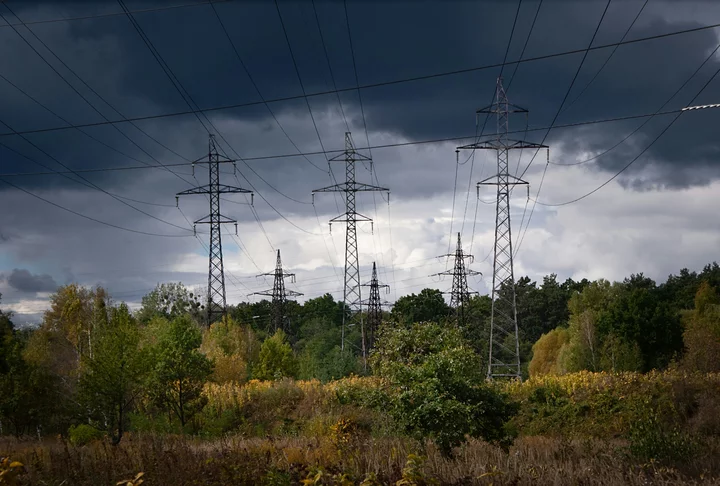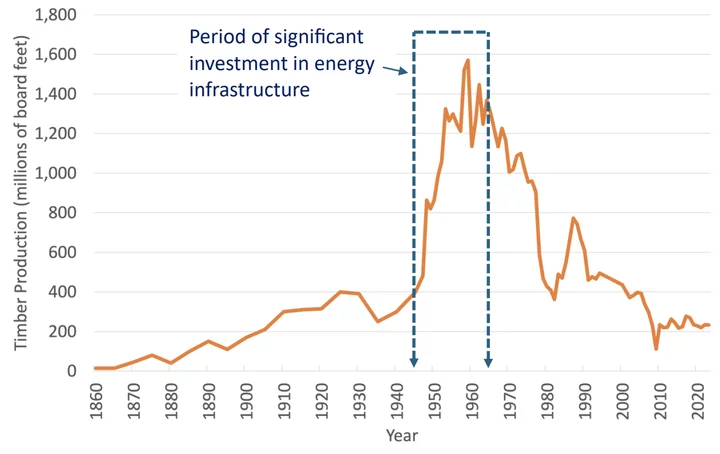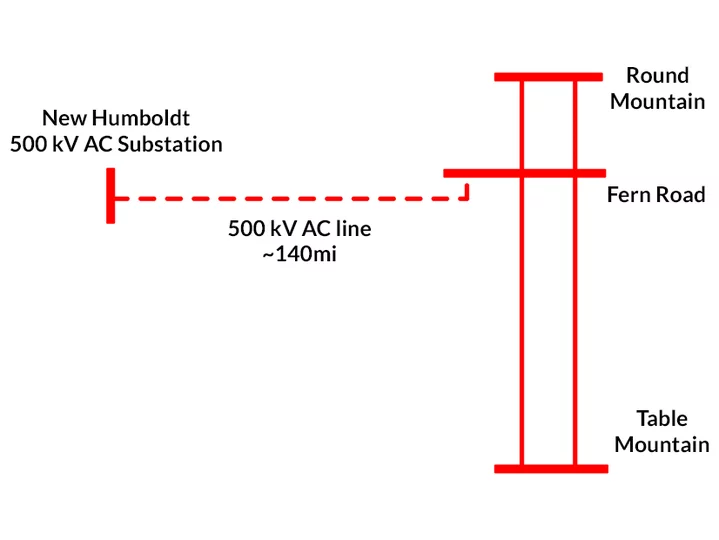Photo: Andriy Nestruiev via Unsplash.
###
Humboldt County’s energy infrastructure needs an upgrade.
A new report from the Schatz Energy Research Center at Cal Poly Humboldt takes a deep dive into the history of the county’s “aging and fragile” energy system and examines why the local system is “among the least reliable in the state.” The report also explores potential pathways to modernization, including significant investments in the renewable energy sector.
Timber production in Humboldt County from 1860 to 2023. | Graph: Schatz Energy Research Center.
Most of Humboldt County’s electrical and natural gas infrastructure was built in the two decades following World War II to support the rapidly expanding timber industry. While some improvements have been made in the decades following the post-war buildout, most investments have focused primarily on “maintaining the capacity and architecture of the existing system, hardening some system components, and – in the case of the nuclear unit of the Humboldt Bay power plant – decommissioning,” the report states.
“The system was designed mainly to serve the needs of a booming timber industry,” the study’s author, Arne Jacobson, told the Outpost in a recent interview. “Following that boom period, there have been investments in maintaining the system, but there really haven’t been any significant investments in expanding the system. A lot of the equipment we’re still relying on is old.”
Some components have been replaced or upgraded, but the overall structure of the local energy system hasn’t changed in sixty-plus years, Jacobson said, adding that it is unlikely to change without a major investment from an external source.
“New infrastructure takes time to build, so you want to make those investments before the crisis point,” he said. “You need to get things going early, so the five to ten years it takes to complete the project doesn’t happen after the issue comes up.”
The floating offshore wind project slated for the Humboldt coast presents a “once in a generation” opportunity to attract the funding needed to upgrade and expand local energy infrastructure, Jacobson said. However, the project’s future has become increasingly uncertain following federal funding cuts and repeated attempts by President Donald Trump to ban offshore wind development in the United States.
Last year, CAISO, the entity that manages the flow of electricity on high-voltage powerlines and oversees infrastructure planning across the state, approved a plan to build the transmission infrastructure needed to support a large-scale offshore wind project. The plan includes major upgrades to the current system, as well as the construction of three new transmission lines that would extend from the “New Humboldt Substation” to the Fern Road Substation in Shasta County and the Collinsville Substation in Solano County.
A schematic of the New Humboldt to Fern Road 500-kV line project. | Image: CAISO
Earlier this year, CAISO selected Viridon, a Chicago-based electric utilities company, to finance, construct, own and operate the new transmission system. The project comes with a staggering $4.5 billion price tag, according to CAISO’s 2023-24 Transmission Plan.
However, if the offshore wind project doesn’t move forward, it seems unlikely that the new transmission system would be built.
“It is precarious … but it’s still on the table,” Jacobson said. “There are a lot of steps before it would be built, and it is possible that the state — if things head in a direction where it’s very clear that offshore wind is not happening [and] there’s not another reason to have to invest in building that infrastructure — would cancel it. That is a real possibility, but there’s been no indication from the state that that’s their plan. I’m sure they’re trying to read the tea leaves along with everyone else.”
If the project moves ahead as planned, the cost of electricity will almost certainly go up, but probably only by a few bucks a year, Jacobson said.
“This is an investment that was approved by the State of California, and therefore the cost is covered by all of the rate payers of California,” he said. “Humboldt County makes up about a quarter of one percent of the electricity demand in California. … One way of thinking about this, from a Humboldt perspective, is that the rest of the state is going to pay for infrastructure to support activity in this region. We’re going to pay our share, but our share is a really tiny fraction of that overall cost.”
“Over a typical transmission lifetime, which is about 50 years, [the cost for ratepayers] comes out to a few dollars per year,” he added. “Not a few dollars per month, but a few dollars per year.”
Jacobson will discuss his new report, “Power Behind the Redwood Curtain: A History of Electric Transmission and Natural Gas Infrastructure in Humboldt County,” at Cal Poly Humboldt on Wednesday, Oct. 29. The talk will be begin at 5:30 p.m. in BSS 116. More information can be found here.



CLICK TO MANAGE